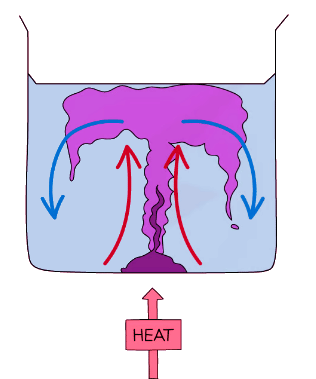Grade 10 Exam > Grade 10 Notes > Physics for Grade 10 > Convection
Convection | Physics for Grade 10 PDF Download
| Table of contents |

|
| Introduction |

|
| Density & Convection |

|
| Demonstrating Convection Currents |

|
| Tips |

|
Introduction
- Convection is the main way that heat travels through liquids and gases
- Convection only occurs in fluids
- Convection cannot happen in solids
Density & Convection
Descriptions of convection currents always need to refer to changes in temperature causing changes in density
- The temperature may fall or rise, both can create a convection current
- When a liquid (or gas) is heated (for example by a radiator near the floor):
- The molecules push each other apart, making the liquid/gas expand
- This makes the hot liquid/gas less dense than the surroundings
- The hot liquid/gas rises, and the cooler (surrounding) liquid/gas moves in to take its place
- Eventually the hot liquid/gas cools, contracts and sinks back down again
- The resulting motion is called a convection current
 When a liquid or gas is heated, it becomes less dense and rises
When a liquid or gas is heated, it becomes less dense and rises - When a liquid (or gas) is cooled (for example by an A.C. unit high up on a wall):
- The molecules move together, making the liquid/gas contract
- This makes the hot liquid/gas more dense than the surroundings
- The cold liquid/gas falls, so that warmer liquid or gas can move into the space created
- The warmer liquid or gas gets cooled and also contracts and falls down
- The resulting motion is called a convection current
Demonstrating Convection Currents
- A simple demonstration of convection in liquids involves taking a beaker of water and placing a few crystals of potassium permanganate in it, to one side, as shown in the diagram above
- When the water is heated at that side, the potassium permanganate will dissolve in the heated water and rise along with the warmed water, revealing the convection current
 Diagram showing an experiment with potassium permanganate to demonstrate convection
Diagram showing an experiment with potassium permanganate to demonstrate convection
Tips
- If a question on heat mentions liquids or gases the answer will probably be about convection.
- Heat does not rise - it is the hot gases or liquids which rise due to the change in density when they were heated.
The document Convection | Physics for Grade 10 is a part of the Grade 10 Course Physics for Grade 10.
All you need of Grade 10 at this link: Grade 10
|
124 videos|149 docs|37 tests
|

|
Explore Courses for Grade 10 exam
|

|
Signup for Free!
Signup to see your scores go up within 7 days! Learn & Practice with 1000+ FREE Notes, Videos & Tests.
Related Searches


















